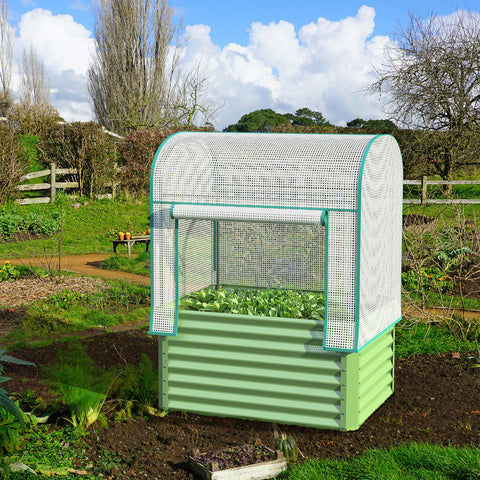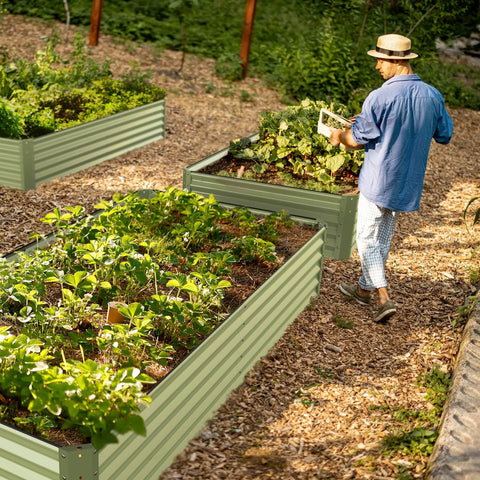Potatoes are grown worldwide as a nutritious, convenient, and storable food. Potatoes are the most consumed vegetable in countries in the Americas, Europe, and Asia.The following content also has some reference value for raised garden beds.
Potato varieties vary in appearance, maturity days, growth requirements, and cooking quality. If you live in a temperate climate region like me, if you plant potatoes in late April, they will be harvested from mid summer to early autumn.
If you choose the variety that is most suitable for local planting conditions and cooking interests, your potato harvest will have the best results.
How to determine when potatoes can be harvested?
The growth of potatoes is usually divided into five stages, which helps to understand when potatoes can be harvested.
In the first stage, the potato seed variety you choose germinates and the root system begins to grow.
In the second stage, photosynthesis begins when the plant develops leaves and branches.
In the third stage, the new tuber develops into swelling of the stolon. Usually, the flowers of potato plants develop during this stage.
In the fourth stage, the tubers expand, and the plant begins to invest most of its resources in the tubers. At this stage, new potatoes can be harvested.
The fifth stage is the signal of tuber maturity, which is the time to harvest potatoes. A clear visual signal is that the crown of the plant will wither and the epidermis of the tuber will harden.
How long does it take for potatoes to grow?
Potatoes are mainly a crop with a cool climate. They grow in over 100 temperate, subtropical, and tropical countries. The life cycle of crops may vary depending on the climate you are in.
Early potatoes require 60 to 100 days of coolness to harvest. For southern regions with very warm or hot summers, early potatoes are the best choice.
Potatoes need 101 to 135 days of coolness to harvest during the season. Late season varieties require 135 to 160 days of coolness or mild frost to harvest.
For northern regions with mild weather throughout the summer, late season potatoes are a good choice.
How climate and potato varieties affect when potatoes are harvested
The minimum/maximum temperature in your area and the potato variety you choose to plant will be the main factors determining when to plant and the time required for planting. Potatoes are grown in early spring in temperate regions and in late winter in warm regions. In the tropical climate, potatoes grow best in the cooler months of the year.
The number of days required for potato varieties to mature also varies depending on the lighting and soil conditions in the garden. Try to choose a planting cycle and potato variety, and mature in a garden environment when the temperature is mild, not exceeding 80 ° F and not less than 40 ° F.
Once the canopy blooms, you can harvest new potatoes, usually around six to eight weeks after the potatoes have grown. These small potatoes have diameters ranging from one inch to two inches. Gently dig next to the plants and dig out a few potatoes from each plant.
Then, dig out the hole and let the remaining tubers mature. Planting with straw can easily harvest some new potatoes without killing the plants. Lift the straw layer, directly remove a few small potatoes under the straw, and then replace the straw layer.
Quickly use new (young, early picked) potatoes after harvest, as thin and immature potato skins can quickly lose water and make it easier for disease pathogens to infect them. Newly harvested potatoes can be stored in the refrigerator for up to a week. New potatoes can be harvested continuously, while tubers can continue to mature underground.
The potatoes you plan to store and use in autumn and winter should be harvested at maturity. Depending on the variety, you can plan to harvest potatoes for 70 to 120 days after they mature. The yellowing or browning of potato stems and leaves indicates that the tubers have matured.
When the top withers, stop irrigating the potatoes. To promote wound healing and tuber maturation, you can use pruning shears to cut off the top of the plant on the soil surface. This is a good practice in areas where humid autumn weather hinders potato harvesting.
After two weeks of withering or pruning of the vines, dig potatoes. Gently irrigating potato crops before excavation can soften soil lumps and reduce potential bruises and tuber damage during the harvesting process.
Here are some quick tips to help you harvest potatoes:
Harvest tubers of any size. The potatoes harvested before maturity are called new potatoes. New potatoes cannot be stored, but must be used immediately.
After the potatoes mature, the skin hardens. The skin of new potatoes easily peels off when rubbed.
Dig out potatoes with a shovel and fork. Gently lift the potato to avoid scratching or damaging its skin. If necessary, use your fingers to harvest potatoes.
Potatoes can be left in the field after ripening until the first frost, but if harvested at maturity, they are the most nutritious.
Protect harvested potatoes from sunlight; Those potatoes exposed to light will turn green and produce a bitter compound called solanine.
Marinate potatoes before storing them. Curing will harden the skin for storage. Place the single layer of tubers in a dark place between 50 ° F and 60 ° F for two weeks to allow them to solidify. Store it at a temperature of approximately 40 ° F
Save the best tubers for the next season to grow potatoes. Do not store potatoes that have become soft or discolored. If any of the potatoes get sick, don't keep them.
Storing potatoes
Store potatoes in a cool and dry place. Do not clean potatoes before storing them, as moisture can accelerate their spoilage. When stored between 45 ° F and 50 ° F, potatoes can be kept fresh for several weeks. When potatoes are stored at room temperature, their quality can be maintained for about a week.
Do not attempt to store tubers that have been scratched or injured due to excavation. Use these potatoes immediately.
Don't put raw potatoes in the refrigerator, as potato starch may turn into sugar in such a cold environment. Refrigerated potatoes may experience excessive browning during cooking, especially during frying, and may have an unsatisfactory sweetness.
Don't put potatoes near fruits. Mature apples and other fruits release ethylene, a plant hormone that stimulates premature germination of potatoes.
Do not store potatoes in areas that will be exposed to sunlight. Botanically speaking, potato tubers are a type of improved stem. Exposure to light can cause dormant tubers to awaken, turn green, and begin to sprout and grow. This green color comes from the plant pigment chlorophyll.









